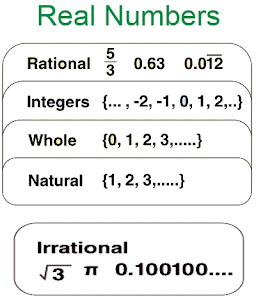Concepts related to the actual numbers have been expanded here with examples and practice questions. The key concept of the number system is included in this post.
Real Numbers
A group of rational numbers and irrational numbers are called real numbers. In other words, a number whose square is always a positive number is called a real number.
In mathematics, a real number is a value representing a sum along a straight line. Real numbers include all rational numbers such as -7, -9, etc. and fractional numbers such as 5/2, 7/4, etc. and all irrational numbers such as √3, √7, etc.
Real numbers can be understanding of as points on an infinitely long line called a number line or real number line, where points comparable to integers are evenly spaced. Any real number can possibly be purposeful by an infinite decimal representation, such as 3.245, where each consecutive digit is measured in units one-tenth the size of the previous one. Real lines can be understanding of as a part of a complex plane, and real numbers can be understanding of as a part of complicated numbers.
Examples
3/4, 7/12, 5.6, 8.3, -6, -9, √6, √2, 5√3, 78√5, etc. are examples of real numbers.
Set of Real Numbers
Real numbers include different types of numbers, such as natural and whole numbers, integers, rational and irrational numbers. All these numbers below are explained with examples.
1. Natural Numbers
In mathematics, numbers 1,2,3, ... etc. are called natural numbers. These numbers are used to count or put things in order.
N = {1, 2, 3, 4, 5, 6.........}
2. Whole Numbers
Natural numbers and zeros combine to form whole numbers.
W = {0, 1, 2, 3, 4, 5.........}
3. Integers
In the number system, a group of all whole numbers and negative numbers are called integers.
Z = {.....-3, -2, -1, 0, 1, 2, 3.....}
4. Rational Numbers
Rational numbers are numbers that can be written as p/q. where q≠0
Q = 3/2, 5/2, 5/4, 1/2 etc.
5. Irrational Numbers
An irrational number is a number that cannot be expressed as p/q for any integer p and q.
Ex- √2, √3
Properties of Real Numbers
There are four main properties of real numbers, which include Commutative Property, Associative Property, Distributive Property, and Identity property.
Suppose m, n, and r are three real numbers. The above properties can be described using m, n, and r.
1. Commutative Property
If m and n are two numbers, then generally m + n = n + m will be for addition and m × n = n × m for multiplication.
Examples
2 + 3 = 3 + 2,
2 × 3 = 3 × 2
2. Associative Property
If m, n, and r are three numbers, then generally (m + n) + r = m + (n + r) will be for addition and (m × n) × r = m × (n × r) for multiplication.
Examples
(2 + 3) + 4 = 2 + (3 + 4),
(2 × 3) × 4 = 2 × (3 × 4)
3. Distributive Property
If m, n, and r are three numbers, then the distributive property is represented as:
m (n + r) = m × n + m × r and (m + n) r = m × r + n × r.
Examples
2 (3 + 4) = 2×3 + 2×4
= 6 + 8 = 14
and
(2 + 3) 4 = 2×4 + 3×4
= 8 + 12 = 20
4. Identity Property
Adding zero to any number does not change the number. Multiplying the number 1 by any does not change the number.
Examples
2 + 0 = 2,
2 × 1 = 2
5. Density Property
The density property tells us that we can obtain another real number from any two real numbers.
For example, between 5.61 and 5.62 are 5.611, 5.612, 5.613, and above.

